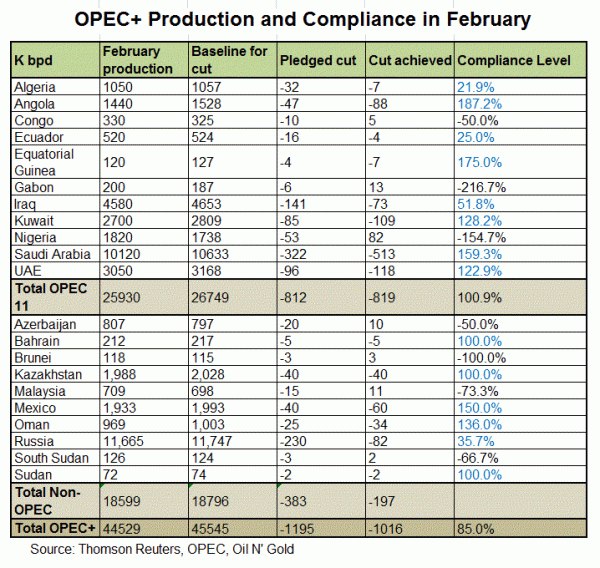At the OPEC+ meeting over the weekend, the members hoorayed for the compliance to the production cut deal, which is expected to reduced output by 1.2M bpd for 6 months through June. As noted in the accompanied statement, “overall conformity reached almost 90%” in February, up from 83% in January. However, after a closer to the figures, it is discovered that not all participating countries adhered to their production quotas. Indeed, half of them either cut less than required or even increased production last month.
Using OPEC’s figures, the overall compliance of OPEC-11 was 105.5%. Saudi Arabia reduced output by 70% more than required. Meanwhile, only Gabon and Nigeria produced more than required. According to Thomson Reuters’ data, the overall compliance by OPEC-11 was 100.9%. Again, most of the output cut was shouldered by Saudi Arabia. The Kingdom reduced output by -513K bpd in February with a compliance level of 159.3%. Other members that cut more than required included Angola, Equatorial Guinea, Kuwait and UAE. The rest either reduced production less than required or produced exceeding their quotas.
For the 10 non-OPEC countries involving in the deal, Russia’s compliance level was merely 35.7%. That is, the countries only reduced output by -82M bpd from the baseline level, although it has agreed to cut by -230K bpd. Kazakhstan, the second largest producer in the group, fully complied with the quota while Mexico, the third largest, cut more than required with a compliance level of 150%. There are four countries (Azerbaijan, Brunei, Malaysia and South Sudan) increased production, instead of cutting, during the month.
In a surprising move, OPEC+ cancelled the meeting April as they required more time to assess the impact of US sanctions on Iran and Venezuela. Iran and Venezuela are currently exempted from production quotas. There is a risk that OPEC+ might decide not to extend the output cuts in the second half of the year, if they judge that the sanctions have significantly affected oil supply from Iran and Venezuela.














